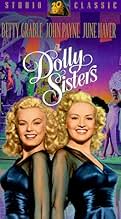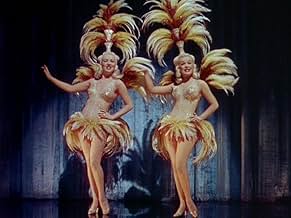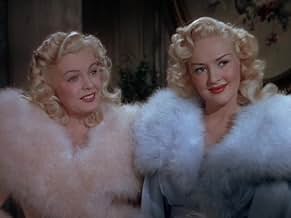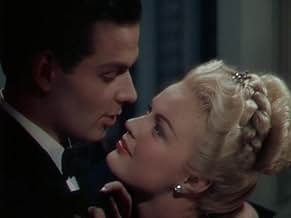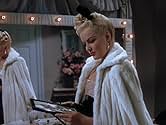Two sisters from Hungary become famous entertainers in the early 1900s. Fictionalized biography with lots of songs.Two sisters from Hungary become famous entertainers in the early 1900s. Fictionalized biography with lots of songs.Two sisters from Hungary become famous entertainers in the early 1900s. Fictionalized biography with lots of songs.
- Director
- Writers
- Stars
- Nominated for 1 Oscar
- 1 nomination total
Fred Aldrich
- Soldier
- (uncredited)
Lester Allen
- Morrie Keno
- (uncredited)
Herbert Ashley
- Fields
- (uncredited)
Nino Bellini
- French Actor
- (uncredited)
Brooks Benedict
- Party Guest
- (uncredited)
Trude Berliner
- German Actress
- (uncredited)
Edward Biby
- Party Guest
- (uncredited)
Lulu Mae Bohrman
- Party Guest
- (uncredited)
Eddie Borden
- Man on Bus
- (uncredited)
- Director
- Writers
- All cast & crew
- Production, box office & more at IMDbPro
Featured reviews
Essentially a more lavish Technicolor remake of the 1940 B&W film "Tin Pan Alley", including two of the stars of the original: John Payne and Betty Grable. Both films have their relative pluses and minuses. I enjoyed the many outlandish costumes of the female stars and of the various extras, a common feature of many 1940s musicals. Grable and June Haver are much more of a sister act than Alice Faye and Grable were in the original, when they mostly performed their own numbers. The troubled on again off again romances, which fill in between musical shows, get awfully tedious, more so than in the original. If Alice Faye had taken Haver's part, as originally planned, it would have been interesting to see if she were again cast as the dominant sister(I doubt it). To me, Faye has more charisma than Haver, but the later makes a more look alike sister for Grable. I really missed Jack Oakie in this one. Frank Latimore was simply not an adequate substitute for Oakie's cheerful comic relief from Payne's serious demeanor. Payne's character is much more of a heel than in the original. That poor foxy woman he led on to believe he cared more for than Grable, left alone in the audience in the final scene, when he was reunited with Grable on the stage!
Betty Grable was considered quite the hot number in her day-a favorite pin-up girl of American soldiers. I always thought she had a crabby look on her face. Be that as it may, this is one of her biggest hits, probably her most lavish musical, made at the peak of her career. An up-and-coming June Haver also stars. Although it has some basis in the lives of the real Dolly sisters, the film makes no effort to be biographical. It traces the rise and heartbreak of the sisters as they conquer vaudeville, Broadway, and Europe singing tunes like "Carolina in the Morning," "Give Me the Moonlight, Give Me the Girl (and leave the rest to Me)," "I'm Always Chasing Rainbows," and the newer tune "I Can't Begin To Tell You," which was a Hit Parade favorite. If you watch a copy that hasn't been cut, the outrageous production numbers are considered the height of kitsch today, "monuments to bad taste" they have been called, that must be seen to be believed. "Darktown Strutters Ball" features Grable and Haver in with bronzed faces, singing in mutilated French, and cavorting around a Harlem set as pig-tailed 'picaninnies' surrounded by deeply tanned chorus girls in hats made of watermelons, dice, and playing cards. At least the girls are made up to look gorgeous and not foolish. It's quite a spectacle. ---from Musicals on the Silver Screen, American Library Association, 2013
This colorful musical directed with great style by Irving Cummings is a delightful way to spend some happy moments. This 1945 Fox film presents the life of two sisters that became a sensation in America at the beginning of the last century. The music is the best excuse to watch this happy movie.
We first meet the young Dolly Sisters, Jenny and Rose, as they arrive in America from their native Hungary. The girls are talented and soon, they are delighting the vaudeville circuit with their charm and talent. Their career soared after Harry Fox, who later became Jenny's husband, introduces them to the great Oscar Hammerstein, who sees in the women, an amazing capacity to entertain the public of the era.
As played by Betty Grable and June Haver, the Dolly Sisters are irresistible! The real sisters were not blond, but who could fault the stars with the disarming way they act in the musical? Ms. Grable and Ms. Haver are a sight for sore eyes!
As the man in Jennie's life, John Payne plays Harry Fox convincingly. Mr. Payne projects a virile figure and he is perfect opposite the gorgeous Betty Grable. His composition in the movie, "I'm Always Chasing Rainbow" was written by Harry Carroll and Joseph McCarthy whose inspiration is the Chopin's Fantasy and Impromptu in C Minor and it blends perfectly in the composition and in the subtext of the film. There are also appearances by that charming character actor, S. Z. Sakall, who plays the girl's uncle. Also Reginald Gardiner does good work as the Duke of Breck.
This is a fine musical that will delight fans of the genre.
We first meet the young Dolly Sisters, Jenny and Rose, as they arrive in America from their native Hungary. The girls are talented and soon, they are delighting the vaudeville circuit with their charm and talent. Their career soared after Harry Fox, who later became Jenny's husband, introduces them to the great Oscar Hammerstein, who sees in the women, an amazing capacity to entertain the public of the era.
As played by Betty Grable and June Haver, the Dolly Sisters are irresistible! The real sisters were not blond, but who could fault the stars with the disarming way they act in the musical? Ms. Grable and Ms. Haver are a sight for sore eyes!
As the man in Jennie's life, John Payne plays Harry Fox convincingly. Mr. Payne projects a virile figure and he is perfect opposite the gorgeous Betty Grable. His composition in the movie, "I'm Always Chasing Rainbow" was written by Harry Carroll and Joseph McCarthy whose inspiration is the Chopin's Fantasy and Impromptu in C Minor and it blends perfectly in the composition and in the subtext of the film. There are also appearances by that charming character actor, S. Z. Sakall, who plays the girl's uncle. Also Reginald Gardiner does good work as the Duke of Breck.
This is a fine musical that will delight fans of the genre.
One of Betty Grables's biggest hits (it grossed over $4 million in 1945) THE DOLLY SISTERS stands as perhaps her splashiest and most lavish musical made at the summit of her career. Originally intended for Alice Faye and Betty, Faye withdrew early in pre-production, not wanting to commit to another exausting musical. Producer George Jessel substituted up-and-coming blonde June Haver, with John Payne (who had worked with Grable numerous times at Paramount and Fox) and Frank Latimore (in a role originally intended for Randolph Scott) as the male-co stars. And although the easy-going Grable usually got on famously with all her female co-stars, June Haver was the exception. It's likely that this was mainly uncharacteristic jealousy on Betty's part - it had taken Grable a decade of hard work to attain her position as Fox's brightest and most bankable actress, while the teenaged Haver had catapulted to stardom in just two years. The fact that none of this animosity shows on screen says a lot for Grables professionalism. As for the storyline...well, to say that it takes great liberties with the lives of its subjects is kind - the real-life Dollys were both small dark brunettes (not leggy blondes), both went through several husbands and Jenny's car accident left her permanently scarred (unlike Grable who gets thru the accident with only a tiny band-aid). Also, the real-life Jenny Dolly was a drug addict who hung herself in 1941 - such elements would certainly be out of place in a bubbly Hollywood musical of 1945! Instead, the film traces the rise and heartbreak of the sisters as they conquer vaudeville, Broadway and Europe, accompanied by numerous nostalgic tunes like "Carolina in the Morning" "Give Me The Moonlight, Give Me The Girl (and leave the rest to Me)" and "I'm Always Chasing Rainbows" and the new James Monaco-Josef Myrow tune "I Can't Begin To Tell You" which was a Hit Parade favorite. What gives the musical its special flavor are its outrageous production numbers by Seymour Felix, which one writer considers to be prime examples of "kitchy vulgarity...monuments to bad taste", which means, naturally that they are irresistably fabulous! "Powder, Lipstick and Rouge" is a Paean to a Make-Up kit ("Beautiful Faces come out of Vanity Cases!") that has to be seen to be believed, and the decidedly un-P.C. "Darktown Strutters Ball" number was usually cut from old TV prints as it featured Grable in Haver in blackface, cavorting around a 'Harlem' set as pig-tailed 'picaninnies' surrounded by chorus girls in hats made of watermelons, dice and playing cards - not until "Springtime for Hitler" in Mel Brooks' THE PRODUCERS was there a musical number that revelled in its tastelessness! Equally eye-catching are the non-stop parade of breathtaking costumes by Orry-Kelly, easily the most lushly glamorous of any Grable film, and both Betty and June look smashing in them. Topping it all off is Fox's succulent Technicolor and elegant set design. Once when a guest on THE CAROL BURNETT SHOW, Grable was asked about a prospective project. She replyed: "It's flashy, it's gaudy, It's vulgar. It's like everything I've ever done. I LOVE IT!" This sums up THE DOLLY SISTERS as well - and you'll love it, too!
I was 8 years old when I first saw this movie in 1945. I was so impressed with the blond beauty of both girls and to know that the Dolly Sisters were real people. June Haver and Betty Grable really looked alike. In my childs mind I thought they were my private dancers and I wanted to be just like them. I actually thought I was the only one who knew about them and they were my secret......What a kid! Thanks for listening. Florence Forrester-Stockton
Did you know
- ConnectionsFeatured in Gotta Dance, Gotta Sing (1982)
- How long is The Dolly Sisters?Powered by Alexa
Details
Box office
- Budget
- $2,510,000 (estimated)
- Runtime
- 1h 54m(114 min)
- Aspect ratio
- 1.37 : 1
Contribute to this page
Suggest an edit or add missing content


